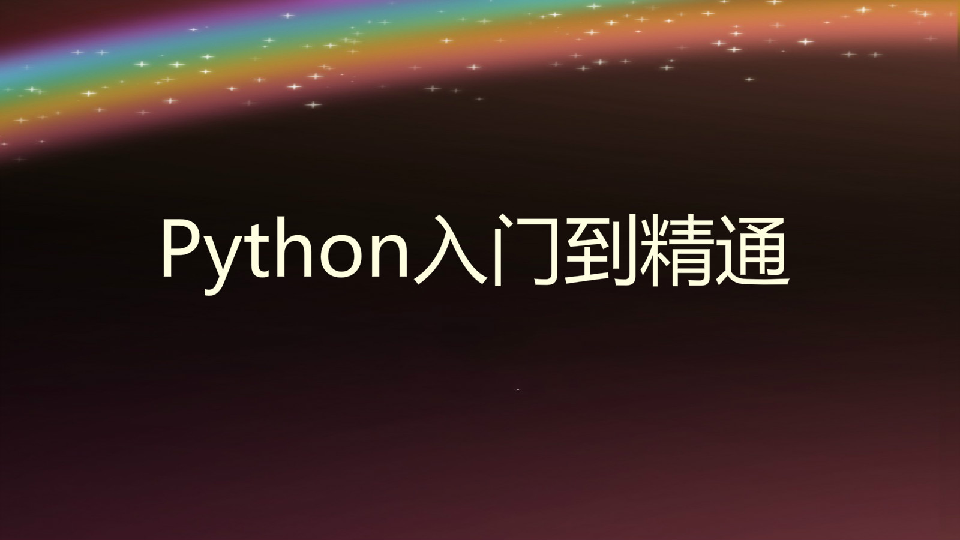1、反转字符串

以下代码使用Python切片操作来反转字符串
注意:很多人学Python过程中会遇到各种烦恼问题,没有人帮答疑容易放弃。为此小编建了个Python全栈免费答疑.裙 :七衣衣九起起巴而五(数字的谐音)转换下可以找到了,不懂的问题有老司机解决里面还有最新Python教程项目可拿,,一起相互监督共同进步!
# Reversing a string using slicing
my_string = "ABCDE"reversed_string = my_string[::-1]
print(reversed_string)
# Output# EDCBA
2、使用标题类(首字母大写)
以下代码可用于将字符串转换为标题类。这是通过使用字符串类中的title()方法来完成。
my_string = "my name is chaitanya baweja"
# using the title() function of string classnew_string = my_string.title()
print(new_string)
# Output# My Name Is Chaitanya Baweja
3、查找字符串的唯一要素
以下代码可用于查找字符串中所有的唯一要素。我们使用其属性,其中一套字符串中的所有要素都是唯一的。
my_string = "aavvccccddddeee"
# converting the string to a settemp_set = set(my_string)
# stitching set into a string using joinnew_string = ''.join(temp_set)
print(new_string)
4、输出 n次字符串或列表
你可以对字符串或列表使用乘法(*)。如此一来,可以按照需求将它们任意倍增。
n = 3 # number of repetitions
my_string = "abcd"
my_list = [1,2,3]
print(my_string*n)
# abcdabcdabcd
print(my_list*n)# [1,2,3,1,2,3,1,2,3]import streamlit as st
一个有趣的用例是定义一个具有恒定值的列表,假设为零。
n = 4my_list = [0]*n # n denotes the length of the required list# [0, 0, 0, 0]
5、列表解析
在其他列表的基础上,列表解析为创建列表提供一种优雅的方式。
以下代码通过将旧列表的每个对象乘两次,创建一个新的列表。
# Multiplying each element in a list by 2
original_list = [1,2,3,4]
new_list = [2*x for x in original_list]
print(new_list)# [2,4,6,8]
6、两个变量之间的交换值
Python可以十分简单地交换两个变量间的值,无需使用第三个变量。
a = 1b = 2
a, b = b, a
print(a) # 2print(b) # 1
7、将字符串拆分成子字符串列表
通过使用.split()方法,可以将字符串分成子字符串列表。还可以将想拆分的分隔符作为参数传递。
string_1 = "My name is Chaitanya Baweja"string_2 = "sample/ string 2"
# default separator ' 'print(string_1.split())# ['My', 'name', 'is', 'Chaitanya', 'Baweja']
# defining separator as '/'print(string_2.split('/'))# ['sample', ' string 2']
8、将字符串列表整合成单个字符串
join()方法将字符串列表整合成单个字符串。在下面的例子中,使用comma分隔符将它们分开。
list_of_strings = ['My', 'name', 'is', 'Chaitanya', 'Baweja']
# Using join with the comma separatorprint(','.join(list_of_strings))
# Output# My,name,is,Chaitanya,Baweja
9、检查给定字符串是否是回文(Palindrome)
反转字符串已经在上文中讨论过。因此,回文成为Python中一个简单的程序。
my_string = "abcba"
m if my_string == my_string[::-1]: print("palindrome")else: print("not palindrome")
# Output# palindrome
10、列表的要素频率
有多种方式都可以完成这项任务,而我最喜欢用Python的Counter 类。Python计数器追踪每个要素的频率,Counter()反馈回一个字典,其中要素是键,频率是值。
也使用most_common()功能来获得列表中的most_frequent element。
# finding frequency of each element in a listfrom collections import Counter
my_list = ['a','a','b','b','b','c','d','d','d','d','d']count = Counter(my_list) # defining a counter object
print(count) # Of all elements# Counter({'d': 5, 'b': 3, 'a': 2, 'c': 1})
print(count['b']) # of individual element# 3
print(count.most_common(1)) # most frequent element# [('d', 5)]
11、查找两个字符串是否为anagrams
Counter类的一个有趣应用是查找anagrams。anagrams指将不同的词或词语的字母重新排序而构成的新词或新词语。
如果两个字符串的counter对象相等,那它们就是anagrams。
From collections import Counter
str_1, str_2, str_3 = "acbde", "abced", "abcda"cnt_1, cnt_2, cnt_3 = Counter(str_1), Counter(str_2), Counter(str_3)
if cnt_1 == cnt_2: print('1 and 2 anagram')if cnt_1 == cnt_3: print('1 and 3 anagram')
12、使用try-except-else块通过使用try/except块,Python 中的错误处理得以轻松解决。在该块添加else语句可能会有用。当try块中无异常情况,则运行正常。
如果要运行某些程序,使用 finally,无需考虑异常情况。
a, b = 1,0
try: print(a/b) # exception raised when b is 0except ZeroDivisionError: print("division by zero")else: print("no exceptions raised")finally: print("Run this always")
13、使用列举获取索引和值对
以下脚本使用列举来迭代列表中的值及其索引。
my_list = ['a', 'b', 'c', 'd', 'e']
for index, value in enumerate(my_list): print('{0}: {1}'.format(index, value))
# 0: a# 1: b# 2: c# 3: d# 4: e
14、检查对象的内存使用
以下脚本可用来检查对象的内存使用。
import sys
num = 21
print(sys.getsizeof(num))
# In Python 2, 24# In Python 3, 28
15、合并两个字典
在Python 2 中,使用update()方法合并两个字典,而Python3.5 使操作过程更简单。
在给定脚本中,两个字典进行合并。我们使用了第二个字典中的值,以免出现交叉的情况。
dict_1 = {'apple': 9, 'banana': 6}
dict_2 = {'banana': 4, 'orange': 8}
combined_dict = {**dict_1, **dict_2}
print(combined_dict)# Output# {'apple': 9, 'banana': 4, 'orange': 8}
16、执行一段代码所需时间
下面的代码使用time 软件库计算执行一段代码所花费的时间。
import time
start_time = time.time()# Code to check followsa, b = 1,2c = a+ b# Code to check endsend_time = time.time()time_taken_in_micro = (end_time- start_time)*(10**6)
print(" Time taken in micro_seconds: {0} ms").format(time_taken_in_micro)
17、列表清单扁平化
有时你不确定列表的嵌套深度,而且只想全部要素在单个平面列表中。
可以通过以下方式获得:
from iteration_utilities import deepflatten
# if you only have one depth nested_list, use thisdef flatten(l): return [item for sublist in l for item in sublist]
l = [[1,2,3],[3]]print(flatten(l))# [1, 2, 3, 3]
# if you don't know how deep the list is nestedl = [[1,2,3],[4,[5],[6,7]],[8,[9,[10]]]]
print(list(deepflatten(l, depth=3)))# [1, 2, 3, 4, 5, 6, 7, 8, 9, 10]
若有正确格式化的数组,Numpy扁平化是更佳选择。
18、 列表取样
通过使用random软件库,以下代码从给定的列表中生成了n个随机样本
import random
my_list = ['a', 'b', 'c', 'd', 'e']num_samples = 2
samples = random.sample(my_list,num_samples)print(samples)# [ 'a', 'e'] this will have any 2 random values
强烈推荐使用secrets软件库生成用于加密的随机样本。
以下代码仅限用于Python 3。
import secrets # imports secure module.secure_random = secrets.SystemRandom() # creates a secure random object.
my_list = ['a','b','c','d','e']num_samples = 2
samples = secure_random.sample(my_list, num_samples)
print(samples)# [ 'e', 'd'] this will have any 2 random values
19、数字化
以下代码将一个整数转换为数字列表。
num = 123456
# using maplist_of_digits = list(map(int, str(num)))
print(list_of_digits)
# [1, 2, 3, 4, 5, 6]
# using list comprehension
list_of_digits = [int(x) for x in str(num)]
print(list_of_digits)# [1, 2, 3, 4, 5, 6]
20、 检查唯一性
以下函数将检查一个列表中的所有要素是否唯一。
def unique(l):
if len(l)==len(set(l)): print("All elements are unique") else: print("List has duplicates")
unique([1,2,3,4])# All elements are unique
unique([1,1,2,3])# List has duplicates
本文的文字及图片来源于网络加上自己的想法,仅供学习、交流使用,不具有任何商业用途,版权归原作者所有,如有问题请及时联系我们以作处理。